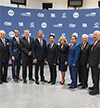Critical Location Decision Factor #2: The Road to Profitability
A well-connected location is essential for accessing suppliers and customers, as well as connecting to intermodal hubs leading to the global marketplace.
Q4 / Fall 2013
A business won’t go anywhere without easy access to well-maintained, high-capacity highways that connect to customers, distributors, and shippers. This is especially true for the logistics and manufacturing industry sectors, where transportation costs typically account for more than 60 percent of all supply chain costs. That’s why excellent highway connections are essential for a well-functioning supply chain, as well as for the on-time delivery of goods to the marketplace. For some site selection projects, highway access should also be viewed in terms of the visibility it creates and ease of access for the work force, especially for labor-intensive operations like call centers and customer service centers. Access to public transit, signage, and the ability of applicants to readily recognize and find the hiring site are all part of the access equation.
Minutes Matter
Highway transportation by truck is often the first domestic stage of shipping for many products — the closer a company’s facility is to interstates and state highways, the faster the products are delivered. “The rule of thumb is ‘5 to 55’ — meaning taking only five minutes to get to 55 miles per hour,” says Tim Feemster, managing principal for Foremost Quality Logistics in Dallas, Texas. The bottom line is that every minute matters.
For example, David Abney, chief operating officer for United Parcel Service, recently testified to the U.S. House of Representatives’ Committee on Transportation and Infrastructure that, “if every UPS delivery vehicle is delayed just five minutes each day, it would cost UPS an additional $105 million annually.” This means good highway connections make a huge difference to controlling operating costs and elevating customer service performance.
Some companies embrace large centralized/regional facilities, while others prefer smaller market-centric facilities. Companies that are delivering products direct to customers or customer outlets tend to prefer the regional/market-centric facility approach to ensure delivery speed and minimize “last mile” delivery costs. Companies shipping raw materials and/or component parts to other companies tend to have larger and more centralized facilities.
Columbus, Ohio, and Indianapolis, Indiana, have been very successful in leveraging their transportation systems to attract business investment. Finish Line’s recent expansion project in Indianapolis exemplifies this trend. The company announced it would create over 300 new jobs by 2015 in a multi-million dollar expansion. Part of this investment will strengthen its distribution system to take better advantage of the four interstate highways that intersect in Indianapolis, providing north-south and east-west transportation connections.
Intermodal’s Role
Depending on the company and its markets, interstates and state highways that connect directly to intermodal centers (rail, port) are essential for cross-country or international delivery of products. Key intermodal sites include the Alliance Intermodal Terminal north of Dallas/Fort Worth (connecting BNSF and interstates 20, 30, 35, and 635); San Antonio Intermodal Terminal (Union Pacific, interstates 35 and 410); and CenterPoint Intermodal Center outside Chicago (BNSF, Union Pacific, interstates 55 and 80). Eastern states with strong connections between their highway systems and deepwater ports — such as Florida, Virginia, Maryland, and South Carolina — will likely see more warehousing and distribution activity with the Panama Canal expansion in 2014.
Although it may be a factor that’s taken for granted, highway accessibility undeniably forms the essential nexus between workers, suppliers, producers, distributors, and markets. The addition of a new highway can transform the economic potential of a region. For example, an interstate has been proposed that would connect Las Vegas and Phoenix, two of the largest metropolitan areas in the Southwest. The proposed interstate, I-11, would also help make Las Vegas Valley cities like Henderson and North Las Vegas distribution hubs in the Southwest, as well as reduce local traffic congestion. Business executives, labor union leaders, and politicians are all behind the project — the hard part now is coming up with the funding — at state or federal levels.
Financing highway construction is one of the most critical issues facing Congress. The Highway Trust Fund is in big trouble — in April 2013 the Congressional Budget Office (CBO) reported, “The current trajectory of the Highway Trust Fund is unsustainable. Starting in fiscal year 2015, the trust fund will have insufficient amounts to meet all of its obligations, resulting in steadily accumulating shortfalls.”
Revenue for this fund is largely generated by excise taxes on gasoline and other motor fuels, which have declined steadily because Americans are driving more fuel-efficient cars and spending less on gas. According to the CBO, these taxes come from an 18.4 cent-per-gallon tax on gasoline and ethanol-blended fuels and a 24.4 cent-per-gallon tax on diesel fuels. Those taxes were last increased in 1993.
Project Announcements
Fluid Cooling Systems Expands Burton, Michigan, Operations
04/24/2025
Fiserv Plans Overland Park, Kansas, Operations
04/22/2025
Custom Air Handling Solutions Expands Burton, Michigan, Manufacturing Operations
04/22/2025
AgriAmerica Fruit Products Expands Chautauqua County, New York, Operations
04/22/2025
The Hershey Company Expands Dauphin, Pennsylvania, Operations
04/21/2025
Delta Star Expands Lynchburg, Virginia, Manufacturing Operations
04/21/2025
Most Read
-
Run a Job Task Analysis
Q4 2024
-
The Location Economics of Advanced Nuclear
Q1 2025
-
39th Annual Corporate & 21st Annual Consultants Surveys: What Business Leaders and Consultants Are Saying About Site Selection
Q1 2025
-
NEW NIMBYism: A Threat to The U.S. Economy
Q4 2024
-
Power, Policy, and Site Selection in 2025
Q1 2025
-
Why Workforce Readiness Can’t Wait
Q1 2025
-
Designing Beyond the Assembly Line
Q1 2025



